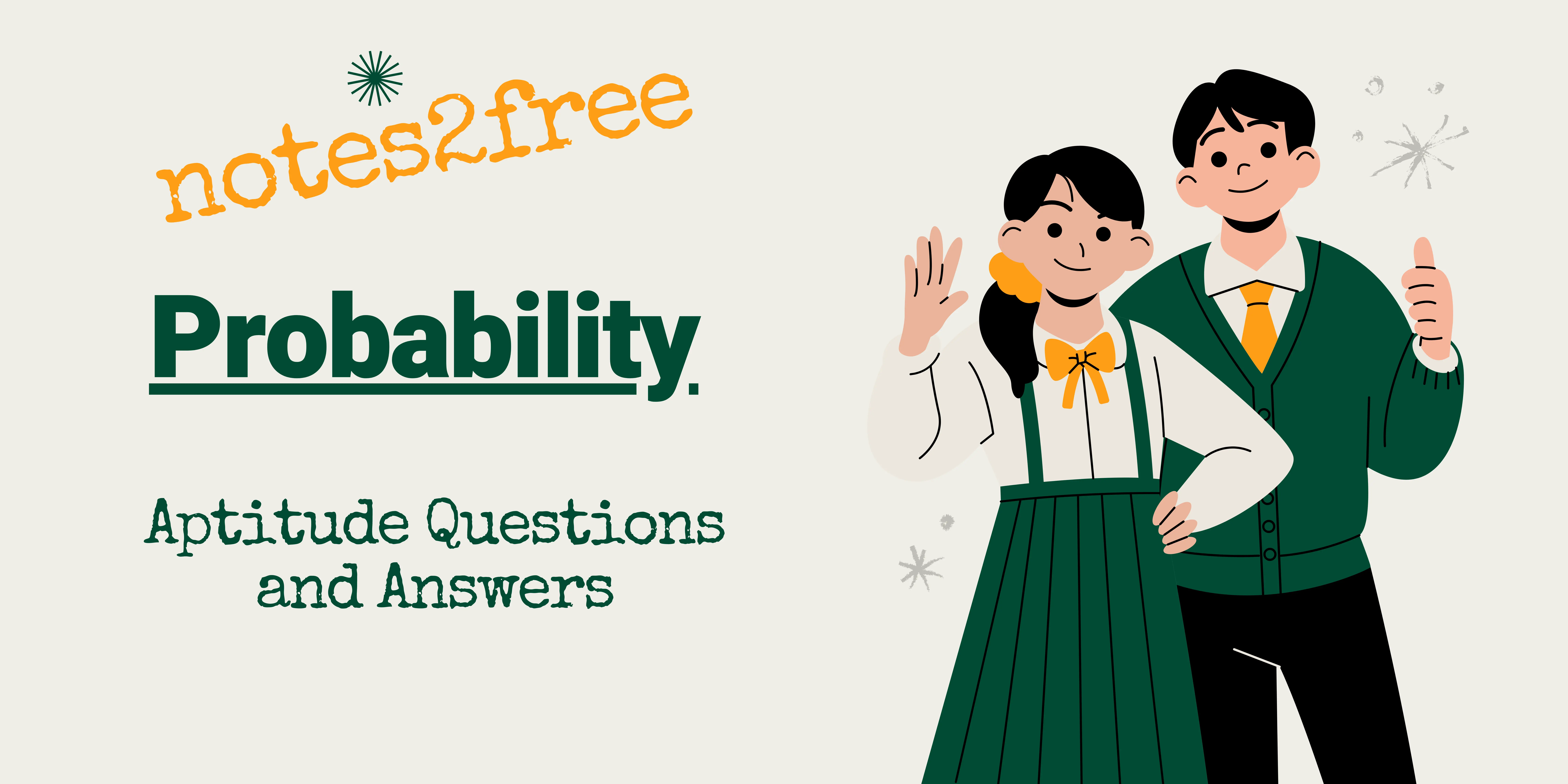
Aptitude questions and answers on Probability
1. Sam and Joan are playing a tennis match. If the probability of Sam`s win is 0.59, then find the probability of Joan`s win.
A. 0.47
B. 0.36
C. 0.41
D. 0.25
The correct answer is C
Explanation:
Let event A = Sam wins and event B = Joan wins. Then,
P(A) = 0.59
Since if Sam wins, Joan cannot win and if Joan wins, Sam cannot win, so we can say that events A and B are mutually exclusive. Other than these two events, there are
no other possible outcomes. So,
P(A)+P(B) = 1
0.59+P(B) = 1
P(B) = 1-0.59 = 0.41
2. Let A and B be events on the same sample space, with P (A) = 0.6 and P (B) = 0.7. Can these two events be disjoint?
A. Yes
B. No
C. None of the above
D. All the above
The correct answer is C
Explanation
These two events cannot be disjoint because P(A)+P(B) >1.
P(A?B) = P(A)+P(B)-P(A?B).
An event is disjoint if P(A?B) = 0. If A and B are disjoint P(A?B) = 0.6+0.7 = 1.3
And Since probability cannot be greater than 1, these two mentioned events cannot be disjoint.
3. A family has two children. find the probability that both the children are girls given that at least one of them is a girl?
A. 1/4
B. 2/3
C. 1/3
D. 1/4
The correct answer is C
Explanation:
Let b stand for boy and g for girl. The sample space of the experiment is
S = {(g, g), (g, b), (b, g), (b, b)}
Let E and F denote the following events :
E : ‘both the children are girls’
F : ‘at least one of the child is a girl’
Then E = {(g,g)} and F = {(g,g), (g,b), (b,g)}
Now E n F = {(g,g)}
Thus P(F) = 3/4
and P (E n F )= 1/4
Therefore P(E|F) = P(E n F)/P(F) = (1/4)/(3/4) = 1/3
4. In a lottery, there are 10 prizes and 25 blanks. A lottery is drawn at random. What is the probability of getting a prize?
A. 1/10
B. 2/5
C. 2/7
D. 5/7
The correct answer is C
Explanation:
P(getting a prize) = 10 / (10+25)
‹=› 10 / 35
‹=› 2 / 7
5. Determine the probability that a digit is chosen at random from the digits 1, 2, 3, …12 will be odd.
A. 1/2
B. 1/9
C. 5/9
D. 4/9
Explanation:
Total no. of Digits = 12. Equally likely cases = 12.
There are six odd digits. Probability = 6 / 12 = 1 / 2
6. Tickets numbered 1 to 20 are mixed up and then a ticket is drawn at random. What is the probability that the ticket drawn has a number which is a multiple of 3 or 5?
A. 1/2
B. 2/5
C. 8/15
D. 9/20
Explanation:
Here, S = {1, 2, 3, 4, ...., 19, 20}.
Let E = event of getting a multiple of 3 or 5 = {3, 6 , 9, 12, 15, 18, 5, 10, 20}.
P(E) = n(E)/n(S) = 9/20.
7. Which of these numbers cannot be a probability?
A. -0.00001
B. 0.5
C. 1.001
D. 1
Explanation:
A probability is always greater than or equal to 0 and less than or equal to 1, hence only a) and c) above cannot represent probabilities: -0.00010 is less than 0 and 1.001
is greater than 1.
8. A pack contains 4 blue, 2 red, and 3 black pens. If 2 pens are drawn at random from the pack, NOT replaced and then another pen is drawn. What is the probability of drawing 2 blue pens and 1 black pen?
A. 2/14
B. 1/14
C. 6/17
D. 8/12
Explanation:
Probability of drawing 1 blue pen = 4/9
Probability of drawing another blue pen = 3/8
Probability of drawing 1 black pen = 3/7
Probability of drawing 2 blue pens and 1 black pen = 4/9 * 3/8 * 3/7 = 1/14
9. In a throw of dice what is the probability of getting a number greater than 5
A. 1/2
B. 1/3
C. 1/5
D. 1/6
Explanation:
A number greater than 5 in 6, so only 1 number
Total cases of dice = [1,2,3,4,5,6]
So probability = 1/6
10. The probability that Soumya will get married within 365 days is `a` and the probability that her colleague Alma gets marry within 365 days is `b`. Find the probability that only one of the two gets married at the end of 365 days.
A. a-b-2ab
B. a+b-2ab
C. a-b+2ab
D. ab-a-b
Explanation:
The probability that Soumya will get marry than Alma will be =a(1-b). Similarly, The probability that Alma will get marry than Soumya will be b(1-a). The probability that
either of these two get marry =a(1-b) +b(1-a) =a+b-2ab.
11. Three unbiased coins are tossed. What is the probability of getting at most two heads?
A. 3/4
B. 1/4
C. 3/8
D. 7/8
Explanation:
Here S = {TTT, TTH, THT, HTT, THH, HTH, HHT, HHH}
Let E = event of getting at most two heads.
Then E = {TTT, TTH, THT, HTT, THH, HTH, HHT}.
P(E) = n(E)/n(S)=7/8.
12. Tickets numbered 1 to 20 are mixed up and then a ticket is drawn at random. What is the probability that the ticket drawn has a number which is a multiple of 3 or 5?
A. 1/2
B. 3/5
C. 9/20
D. 8/15
Explanation:
Here, S = {1, 2, 3, 4, ...., 19, 20}.
Let E = event of getting a multiple of 3 or 5 = {3, 6 , 9, 12, 15, 18, 5, 10, 20}.
P(E) = n(E)/n(S) = 9/20.
13. In a lottery, there are 10 prizes and 25 blanks. A lottery is drawn at random. What is the probability of getting a prize?
A. 2/7
B. 5/7
C. 1/5
D. 1/2
Explanation:
Total number of outcomes possible, n(S) = 10 + 25 = 35
Total number of prizes, n(E) = 10
P(E)=n(E)/n(S)=1035=27.
14. A bag contains 12 white and 18 black balls. Two balls are drawn in succession without replacement. What is the probability that first is white and the second is black?
A. 18/145
B. 18/29
C. 36/135
D. 36/145
Explanation:
The probability that the first ball is white:
=12C1/30C1
=1230
=25
Since the ball is not replaced; hence the number of balls left in the bag is 29.
Hence, the probability the second ball is black:
=18C1/29C1
=18/29
Required probability,
=(25)×(18/29)
=36/145.
15. A bag contains 5 red and 3 green balls. Another bag contains 4 red and 6 green balls. If one ball is drawn from each bag. Find the probability that one ball is red and one is
green.
A. 19/20
B. 17/20
C. 8/10
D. 21/40
Explanation:
Let A be the event that the ball selected from the first bag is red and the ball selected from the second bag is green.
Let B be the event that the ball selected from the first bag is green and the ball selected from the second bag is red.
P(A)=(5/8)×(6/10)=3/8 and P(B)=(3/8)×(4/10) =3/20
Hence, required probability,
=P(A)+P(B)
=3/8+3/20
=21/40.
